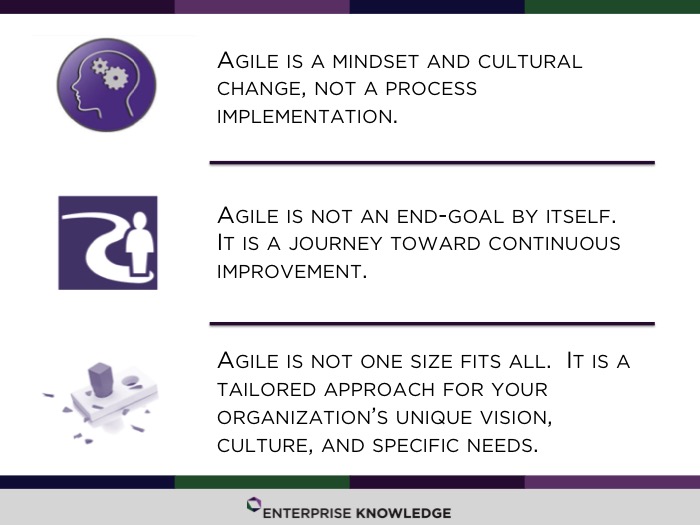Often we hear organizations are “going” agile and trust that they are successfully embracing core agile philosophies and reaping the benefits. Yet, for most organizations, this effort seems to generate complex organizational problems that result in unintended process, people and/or business failures. At EK, we’re commonly asked how can organizations identify causes, detect failure trajectories early, and become equipped to avoid such pitfalls while they transition to agile?
Understanding the current agile state is imperative. We often see organizations asking questions, such as:
- Is agile a destination or a means to an end?
- Is the organization keeping scorecards on “going” agile or does it really care about better business results?
- How much of this is communicated to employees to see how it relates to their work?
These questions often trigger responses that are telltale signs for the lack of meaningful understanding on the real drive behind the agile transformation. This is what results in lack of vision; wasted resources, high chance of abandonment during the process and inability for the organization to quickly respond to market opportunities or threats.
Our experience working with multiple organizations facing these challenges is what has shaped our approach to successful agile transformations. Here, we share our take on common reasons for failure and key recommendations to help organizations answer these questions.
Agile is NOT a process implementation, but a shift in mindset and a cultural transformation. Agility is a change in our way of thinking, assumptions, notions, and incentives that drive our actions and thus guide our processes and approaches. This is more important than forcing company policies and procedures to change or trying to implement agile as a solution. According to the 10th State of Agile Report, the top causes of agile adoption failures revolve around the organization’s culture being at odds with agile core values. This impacts the ability to change as an organization and fuels the lack of support for cultural transition for employees.
A well-prepared organization will invest in cultivating an agile mindset across teams to give birth to the collective agile way of thinking. This will result in teams who are motivated to self-organize, collaborate, innovate, and experiment to overcome obstacles, and ask questions to understand and act in the best interest of the business. One approach we recommend is complementing the agile adoption process with change management activities. This approach fosters buy-in and ensures the agile vision, goals, and benefits are well-communicated to your employees.
Agile is NOT an end-goal, but a journey toward continuous improvement. Although agile is historically associated with software development, organizations have proven to realize the value of agile successfully in various business units in order to deliver specific business results. Usually, the decision for most organizations to start the agile transformation process is driven by:
- Building the right/quality products,
- Quick delivery to market,
- Getting faster return on investment (ROI), and/or
- Gaining visibility and transparency.
 The application of project management methodologies, processes and tools is not the destination, rather a means to reach an end. Informed organizations recognize that agile frameworks such as Scrum, Kanban, or Lean use a set of tools and methods that integrate effective planning and development strategies to help organizations constantly deliver toward specific business goals. That is a continuous journey.
The application of project management methodologies, processes and tools is not the destination, rather a means to reach an end. Informed organizations recognize that agile frameworks such as Scrum, Kanban, or Lean use a set of tools and methods that integrate effective planning and development strategies to help organizations constantly deliver toward specific business goals. That is a continuous journey.
Agile is NOT a one size fits all; but a tailored approach for your organization’s unique vision, unique culture, and specific needs. At EK, we’ve found that many agile adoption approaches fail because they tend to focus heavily on pushing business units and/or individual teams to follow prescribed approaches that may not take existing organizational strengths and weaknesses into account. The particular requirements of an organization’s culture, business domain, or scale of projects may not be adequately addressed by predefined agile practices. Most agile frameworks such as Scrum, Kanban, or XP, recognize this dilemma and suggest that processes be tailored to fit each unique situation.
When your organization is considering agile adoption or if the existing transformation process is not working, it is vital to take a step back to identify the weak points and guide teams to customize and enhance boilerplate approaches to make it your own.
Overall, an agile transformation will only be successful and sustainable if it begins with a full understanding of the core values of “becoming” agile. An organization must be able to explicitly deliver the intended business rationale but be willing to change supporting processes and organizational frameworks. This holistic approach will inform and improve the end-to-end delivery process and thus maximize success throughout the agile transformation.
Are you in the midst of “going” agile? Are you looking to help your organization develop an agile mindset? Our experience has proven that developing an effective approach is achievable and scalable. EK has developed a Quick Starter Kit for Agile that applies a four-step approach to activate agile within organizations by: 1) Ensuring key stakeholders have a common understanding of agile concepts and benefits; 2) Identifying underlying structural and organizational culture challenges to determine effective change management responses; 3) Envisioning agile benefits, desired outcomes, and how to measure success; and 4) Planning to develop a concise, contextualized strategy for agile transformation. The outcome of this approach provides you with actionable next steps to accelerate and actualize agile at the enterprise level. Learn more on how our agile design can actualize success and maximize your investments in your agile transformation.
